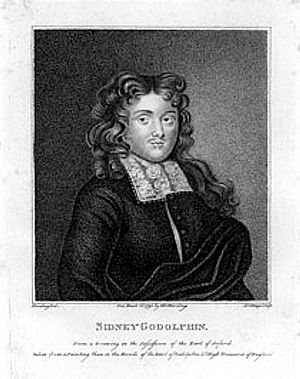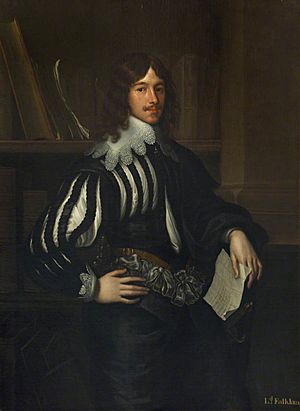Sidney Godolphin (poet) facts for kids
Quick facts for kids
Sidney Godolphin
|
|
|---|---|

Sidney Godolphin
|
|
| Member of Parliament for Helston |
|
| In office November 1640 – February 1643 |
|
| Governor of Scilly | |
| In office 1636–1643 |
|
| Personal details | |
| Born | 14 January 1610 (baptised) Breage, Cornwall |
| Died | 8 February 1643 (aged 33) Okehampton |
| Resting place | All Saints, Okehampton |
| Nationality | English |
| Alma mater | Exeter College, Oxford |
| Occupation | Poet and courtier |
| Military service | |
| Years of service | 1639 to 1643 |
| Battles/wars | Bishops' Wars First English Civil War Braddock Down |
Sidney Godolphin was an English poet and a member of the royal court. He was born on January 14, 1610, and died on February 8, 1643. He was also a Member of Parliament (MP) for Helston in Cornwall. During the First English Civil War, he fought for the Royalist army. He was killed in a small fight near Chagford in Devon.
Contents
About Sidney Godolphin
Sidney Godolphin was born in Breage, Cornwall. He was the second son of Sir William Godolphin and his wife, Thomasine. He had two brothers, Francis and William, and a sister, Penelope. Sidney never married and did not have any children. When he was only three years old, both his parents passed away.
Sidney's Life and Work
Because he was an orphan, Sidney inherited money from his mother's family. This meant he had enough money to live on his own. He went to Exeter College, Oxford, from 1624 to 1627. After college, he studied law. This was common for young men from important families at the time.
In 1628, Sidney became a Member of Parliament (MP) for Helston. His brother Francis was also an MP for the same area. Sidney didn't play a big role in Parliament before it was closed down in 1629. This started a period of eleven years when King Charles I ruled without Parliament.
Travels and Court Life
After Parliament closed, Sidney spent a few years traveling. He visited France and the Low Countries (modern-day Belgium and the Netherlands). In 1632, he went on a special trip to Denmark-Norway with a distant relative, Robert Sidney.
When he returned to England, Sidney lived at the royal court. He became part of a group of writers and poets known as the Great Tew circle. This group was led by Lucius Cary, 2nd Viscount Falkland. Other famous people in this group included Edward Hyde, 1st Earl of Clarendon and the thinker Thomas Hobbes. Hobbes later wrote a famous book called Leviathan and dedicated it to Sidney's brother, Francis.

Governor of Scilly
For many years, Sidney's family, the Godolphins, were in charge of the Isles of Scilly. When his younger brother William died in 1636, Sidney took over as the Governor of the islands.
In 1639, during the Bishops' Wars, Sidney served in the army. He was part of a group of horse riders led by Sir Ralph Hopton. However, he didn't see any fighting during this time.
Sidney was re-elected as an MP for Helston in April 1640 and again in November 1640.
English Civil War
Sidney always supported King Charles I. In May 1641, he was one of 59 MPs who voted against a special law to punish a powerful leader named Thomas Wentworth, 1st Earl of Strafford. Because of this vote, these MPs were called "betrayers of their country." Many other MPs who voted with Sidney, like Nicholas Slanning and John Trevanion, later died fighting for the King. Most of the MPs who supported the King left Parliament in April 1642, but Sidney stayed until just before the First English Civil War started in August.
Sidney chose not to be an officer in the army. Instead, he served as a regular soldier in the Royalist army in the west of England. This army was led by Sir Ralph Hopton. Even though Sidney didn't have much military experience, his advice was highly valued.
In January 1643, he fought in the Battle of Braddock Down. The Royalists won this battle, which helped King Charles I gain control of Cornwall. This victory also allowed Hopton's army to move into Devon.
Sidney was part of a small group of soldiers looking for the enemy. This group was led by John Berkeley. They were ambushed by Parliamentarian soldiers while passing through the town of Chagford. During the fight, Sidney was shot and killed. He was buried two days later, on February 10, 1643, in All Saints Church in Okehampton.
Sidney's Poems
Sidney Godolphin wrote many poems, but they were never put together in a single book during his lifetime. One of his poems, "The Passion of Dido for Æneas," was finished by another poet, Edmund Waller. It was published in 1658 and 1679. Another of his songs can be found in a collection called Specimens of the Early English Poets. Some of his other poems are kept as old handwritten papers in libraries. He also wrote a poem about John Donne and some verses that appeared in other books.
Haunting Story
Some people say that Sidney Godolphin's ghost walks the halls of The Three Crowns Hotel in Chagford. They believe he appears in his old army uniform.

